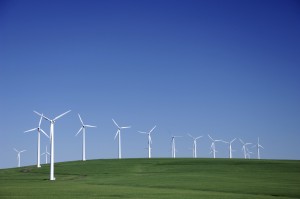Why a Focus on Energy Consumption Alone Fails to Produce Great Results

Mandates to improve resource use often focus only on resource consumption. You hunt through bills, map your energy costs to energy use, and before long, you’re knee deep in everyone’s favorite swamp – data – waiting for the savings to bubble up. Without new ideas or new funding, you’re left trying to squeeze new savings out of the same systems. This discussion explores how a look at your entire energy chain helps you out of that trap.
Knowing how your energy buys, your infrastructure, operations, utility rates, and energy consumption are all interconnected open your project to strategies for superior results. So let’s explore the energy chain idea.
What’s My Energy Chain?
Think more biology textbook than physics – this energy chain is like the food chain. Your energy consumption is the proud lion, an apex predator of kilowatt hours. Zoom out from what the lion eats to the kingdom it surveys. How was the power it consumes generated? How did you buy it? What decisions about your infrastructure and assets affect your cost model? Energy consumption is just one link in an entire chain of actions and decisions that affect your actual energy costs.
Most organizations don’t look at the whole chain when they target energy for cost savings. Let’s jump up to that thousand-foot view and see what comprehensive and creative energy-saving strategies come into focus.
How Was Your Power Generated?
A big part of the cost of energy is generating it. No matter the source – and how our communities feel about the pros and cons of each source – the power company has to pass that cost on to you, the energy consumer.
So, what if it’s possible to find energy savings by seeing that cost of generation as something you can control? You probably haven’t bought into the power industry since the last time you played Monopoly, but it’s easier than that.
Consider this: in 2016, a solar installation bid a price for selling kilowatt hours that beat prices from the cheapest fossil fuel source, natural gas. Solar still has the ring of a sustainability strategy – and that’s not a bad sound – but it’s now also an extremely viable cost reduction strategy. Large US businesses were already getting on board by 2015 – 55% according to a Deloitte study.
The radically lower costs of solar installation – 70% lower in 2018 than 2010 – explains why a new solar project was installed every 100 seconds of 2018 in the US. Looking at your whole energy chain, how would generating your own power from solar increase your energy savings?
- Generate a new revenue stream
- Stabilize your electricity costs
If you pay peak pricing for energy, generating your own power during peak pricing times can make a significant difference, especially if you can’t avoid or reduce consumption during peak times. Advances in battery storage can also help you stabilize costs and mitigate solar’s cloud cover drawback.
Depending on your ROI targets and how much generating your own power is saving you, other methods can also be a boon. Wind generation, biomass, fuel cells, and combined heat and power (CHP) are all worth considering for your energy chain.
Yes, there’s some complexity here. Tax credits, depreciation, and other incentives are all factors in your early return on investment, as are the details of project design, management and installation.
How Does Your Power Get to You?
If less complexity fits your saving strategy, you could look at the distribution part of your energy chain. When you buy directly from the utility, they usually subject you to the market forces acting on power distribution.
Instead of buying directly from the utility, you could purchase energy from a third-party supplier. They buy power from the grid and repackage it for clients. A fixed energy contract can protect you from those fluctuating prices, and ease management and budget projections.
There can be downsides to fixed energy contracts; that’s another reason why the thousand-foot view of your energy chain is important. Balancing the value of stability against what you can save at other links in the chain is important. Some third-party energy suppliers can help here too.
For instance, insights into your own demand generation can help you take advantage of demand response programs. In effect, energy consumers able to cost-effectively reduce use during high-demand times can take advantage of that – in some cases even generating revenue based on the load they can take off the system.
Where Does Your Power Go?
We say energy is used, we talk about consumption – as if what we pay for goes away. Let’s bring that physics textbook back a second. Energy is neither created nor destroyed, it just changes forms. The form that concerns us is the benefits it gets you.
Let’s look ahead on your energy chain to why you consume that energy. What does buying power actually buy for you? Because a strategic look at how you benefit from energy spending can reveal saving strategies that better fit those benefits.
Answers will be as unique as your facility. Controlling environmental factors like humidity, temperature, or particulate count affects product yields, avoids waste; in a healthcare facility those controls can slow or stop disease vectors. Lighting levels and comfort drive employee engagement, affecting labor and turnover costs. In a fast-paced office or a college classroom, those engagement numbers could tie directly to client satisfaction or student retention.
Maybe those examples don’t cover the benefits you’re targeting, but you get the picture: your infrastructure, your assets, and your operations transform energy into benefits. A lot of decisions affect that:
- Design and implementation
- Asset management
- Operations and controls
With the right assets serving the right goals, efficiency at the consumption level gets easier. If updating infrastructure feels out-of-scope for your energy savings project, take another look at your benefit metrics, and then talk to an energy performance contractor. They specialize in devising plans that get asset upgrades, redesigns and retrofits done with less – sometimes zero – need for new capital investment, so you can start realizing the benefits of your plan now.
Once energy spending is solving the right problems, delivering the value that makes a difference for you, now you can protect your capital plans and operational efficiencies with asset management and integrated services.
Putting the Chain Together – To Free Up Your Strategy
Once we’ve looked at all the links of your energy chain, how they come together can have a big impact. Now those consumption numbers you started with have a lot more context, and there’s a lot more opportunity for savings.
Those opportunities do come with some complexity and are probably going to involve third parties. After all, you’re not in the energy business. To stave off development bloat and project management headaches, look for a partner that can help you integrate the whole process. From assessments to implementation is a lot of steps, but experienced providers can help you get started – often offering advice early on free of charge – and can really drive savings across your whole project.
Taking Control
Step one will be getting your team focused – and comfortable – with the insights you’re going to generate looking at your whole energy chain. Once you’ve done that, taking control of your energy spending will empower you to drive more savings than just consumption strategies. Talking to an energy partner can help you get started.
By Dan Dowell, Senior VP Bundled Energy Solutions at ABM Industries You can find the article here
